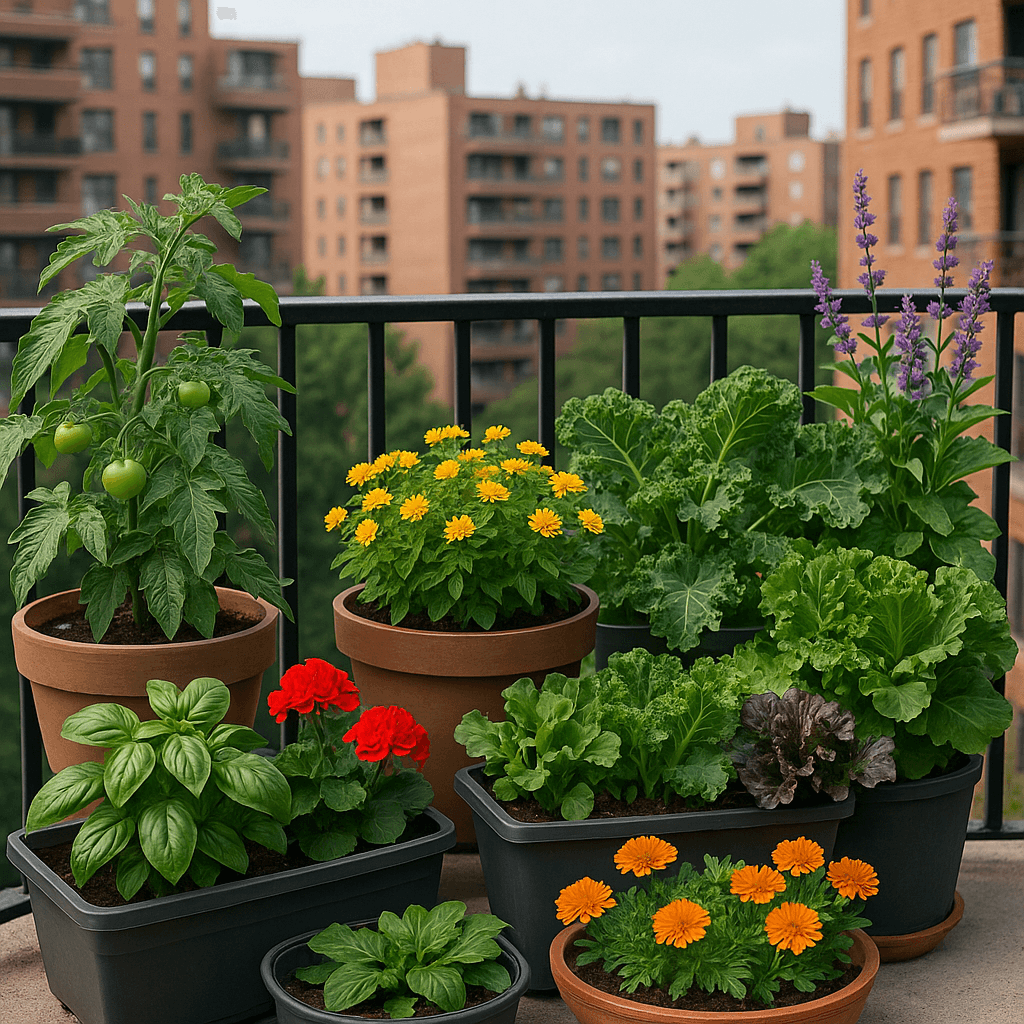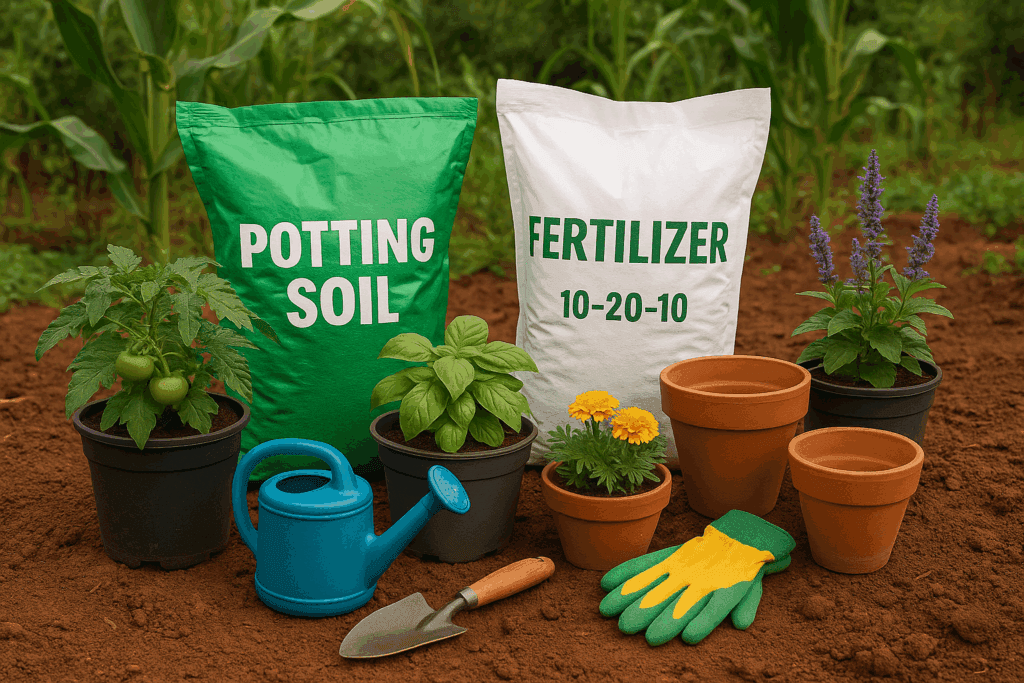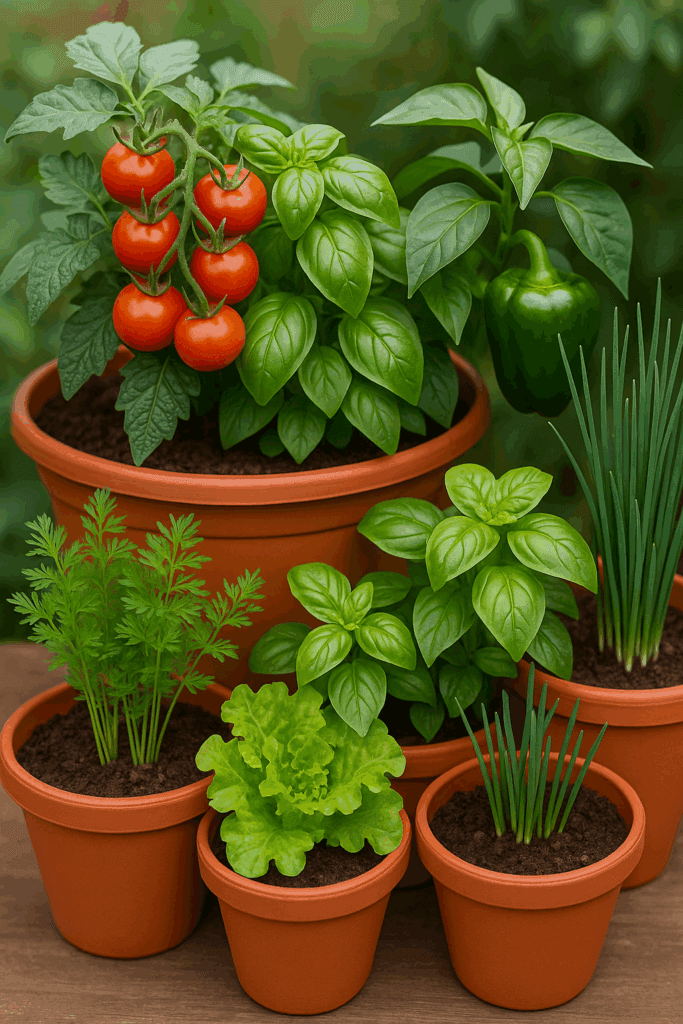
Container Gardening 101: Grow Food in Any Space

Imagine transforming your tiny balcony or windowsill into a lush, productive garden. Sounds impossible? Think again! Container gardening is revolutionizing the way urban dwellers and space-strapped individuals approach growing their own food. Whether you’re living in a cramped apartment or simply don’t have access to a traditional garden plot, container gardening offers a solution that’s both practical and rewarding.
But where do you start? The world of container gardening can seem overwhelming at first glance. What containers should you use? Which plants will thrive in limited spaces? How do you ensure a bountiful harvest? Don’t worry – we’ve got you covered. In this comprehensive guide, we’ll walk you through everything you need to know to start your own thriving container garden, from selecting the right pots to maximizing your yield and overcoming common challenges.
Get ready to dig in as we explore the seven key aspects of successful container gardening. By the end of this post, you’ll be equipped with the knowledge and confidence to grow your own fresh, delicious produce – no matter how small your space may be. Let’s embark on this green-thumbed journey together and discover how you can become a master container gardener!
Benefits of Container Gardening
A. Space-saving solution for urban dwellers
Container gardening is a game-changer for city residents with limited outdoor space. By utilizing containers, you can transform even the smallest balconies, patios, or windowsills into thriving gardens. Here’s how container gardening maximizes space:
- Vertical gardening: Stack containers or use hanging planters to grow upwards
- Multi-tiered planters: Cultivate multiple plants in a single footprint
- Railing planters: Utilize balcony railings for additional growing space
- Window boxes: Turn unused windowsills into mini-gardens
B. Flexibility to grow food anywhere
The beauty of container gardening lies in its adaptability. You can place containers wherever conditions are most favorable:
- Sunny spots: Move pots to catch maximum sunlight
- Protected areas: Shelter plants from harsh weather
- Indoors: Bring containers inside during extreme temperatures
| Location | Advantages |
|---|---|
| Balcony | Fresh air, natural light |
| Rooftop | Ample sun exposure |
| Patio | Easy access, wind protection |
| Indoors | Year-round growing, climate control |
C. Better control over soil and growing conditions
Container gardening offers precise control over your plants’ environment:
- Customize soil mix for each plant’s needs
- Adjust watering and fertilization easily
- Modify pH levels for specific crops
- Create microclimates by moving containers
D. Easier pest management
Managing pests in container gardens is often simpler than in traditional gardens:
- Isolate affected plants quickly
- Inspect plants more thoroughly due to accessibility
- Apply targeted treatments without affecting other plants
- Implement physical barriers like netting or screens more easily
With these benefits, container gardening empowers urban dwellers to grow their own food, regardless of space constraints. Now, let’s explore how to choose the right containers for your garden.
Choosing the Right Containers
Size considerations for different plants
When choosing containers for your garden, size matters. Different plants have varying root systems and space requirements. Here’s a quick guide:
| Plant Type | Recommended Container Size |
|---|---|
| Herbs | 6-8 inches deep |
| Lettuce | 4-6 inches deep |
| Tomatoes | 12-18 inches deep |
| Peppers | 12-14 inches deep |
| Root vegetables | 12-18 inches deep |
Remember, larger containers retain moisture better and require less frequent watering.
Material options: pros and cons
Container materials can impact plant health and aesthetics. Consider these options:
- Plastic: Lightweight, affordable, retains moisture
- Terracotta: Porous, allows air flow, can dry out quickly
- Wood: Natural look, insulates roots, may rot over time
- Metal: Modern appearance, conducts heat, can overheat roots
Ensuring proper drainage
Proper drainage is crucial for healthy plants. Follow these tips:
- Choose containers with drainage holes
- Add a layer of gravel at the bottom
- Use well-draining potting mix
- Elevate containers slightly for better air circulation
Upcycling household items as planters
Get creative with these upcycled planter ideas:
- Old boots or shoes
- Tin cans (painted for added charm)
- Wooden crates or pallets
- Colanders or strainers
- Repurposed drawers
Now that you’ve selected the perfect containers, let’s move on to the essential supplies you’ll need for successful container gardening.
Essential Container Gardening Supplies

High-quality potting soil
When it comes to container gardening, the foundation of your success lies in choosing the right potting soil. Unlike garden soil, potting soil is specifically formulated for containers, providing better drainage and aeration for your plants.
Key components of high-quality potting soil:
- Peat moss or coco coir
- Perlite or vermiculite
- Compost or aged bark
Look for potting mixes that are lightweight, well-draining, and rich in organic matter. Avoid heavy soils that can become compacted in containers, leading to poor root growth and drainage issues.
Fertilizers and nutrients
Container plants require regular feeding to thrive. Choose fertilizers tailored to your plants’ needs:
| Type of Fertilizer | Best For | Application Frequency |
|---|---|---|
| Slow-release granules | Long-term feeding | Every 2-3 months |
| Liquid fertilizers | Quick nutrient boost | Every 2-4 weeks |
| Organic compost tea | Natural option | Monthly |
Remember to follow package instructions to avoid over-fertilizing, which can harm your plants.
Watering tools
Proper watering is crucial for container gardens. Essential watering tools include:
- Watering can with a long spout
- Self-watering containers
- Moisture meters
- Drip irrigation systems for larger setups
Plant supports and trellises
Many container plants benefit from support structures:
- Tomato cages for determinate tomatoes
- Bamboo stakes for climbing beans
- Vertical trellises for cucumbers and peas
- Small obelisks for flowering vines
Choose supports that fit your container size and plant variety. With these essential supplies, you’ll be well-equipped to start your container garden journey. Next, we’ll explore the best plants to grow in your newly prepared containers.
Best Plants for Container Gardens
Herbs for small spaces
Herbs are perfect for container gardening, especially in small spaces. Here’s a list of herbs that thrive in pots:
- Basil
- Mint
- Rosemary
- Thyme
- Cilantro
- Parsley
- Chives
These herbs not only add flavor to your meals but also require minimal space and care.
Vegetables that thrive in pots
Many vegetables can be successfully grown in containers. Here’s a table showcasing some popular choices:
| Vegetable | Container Size | Sun Requirement |
|---|---|---|
| Tomatoes | 5-gallon | Full sun |
| Peppers | 3-gallon | Full sun |
| Lettuce | 1-gallon | Partial shade |
| Carrots | 12-inch deep | Full sun |
| Zucchini | 5-gallon | Full sun |
Dwarf fruit trees for containers
For those looking to grow fruit in limited space, dwarf fruit trees are an excellent option. Some popular choices include:
- Meyer Lemon
- Dwarf Apple
- Dwarf Peach
- Fig
- Dwarf Cherry
These trees can be grown in large containers (15-20 gallons) and provide fresh fruit right on your patio or balcony.
Edible flowers to add color and flavor
Adding edible flowers to your container garden not only enhances its visual appeal but also provides unique flavors for your culinary creations. Some popular edible flowers include:
- Nasturtiums
- Pansies
- Marigolds
- Violets
- Borage
These flowers can be grown in small pots or mixed with herbs and vegetables for a diverse and colorful container garden.
Now that we’ve explored the best plants for container gardens, let’s move on to the essential planting and care techniques to ensure your container garden thrives.
Planting and Care Techniques
Proper soil preparation
Preparing the right soil mix is crucial for successful container gardening. A well-balanced soil ensures proper drainage, aeration, and nutrient retention. Here’s a simple recipe for an ideal container soil mix:
| Component | Ratio | Purpose |
|---|---|---|
| Potting soil | 60% | Base medium |
| Compost | 20% | Nutrient source |
| Perlite or vermiculite | 20% | Improved drainage |
Mix these components thoroughly before filling your containers. Add a slow-release fertilizer to provide essential nutrients throughout the growing season.
Correct planting depth and spacing
Proper planting depth and spacing are essential for healthy plant growth in containers. Follow these guidelines:
- Small plants (herbs, lettuce): 2-3 inches apart
- Medium plants (peppers, eggplants): 4-6 inches apart
- Large plants (tomatoes, squash): One per container
Plant seeds at a depth of 2-3 times their diameter. For transplants, ensure the soil level matches the original container’s soil line.
Watering strategies for containers
Container plants require more frequent watering than in-ground gardens. Implement these watering techniques:
- Water deeply until it flows from drainage holes
- Use self-watering containers or drip irrigation systems
- Apply mulch to retain moisture
- Water in the morning to reduce evaporation
Pruning and maintenance tips
Regular maintenance keeps your container garden thriving:
- Pinch off growing tips to encourage bushier growth
- Remove dead or yellowing leaves promptly
- Stake tall plants for support
- Rotate containers periodically for even sun exposure
With these planting and care techniques, your container garden will flourish in any space. Next, we’ll explore how to maximize your container garden’s yield for optimal harvests.
Maximizing Your Container Garden’s Yield

Companion planting in containers
Maximize your container garden’s potential by implementing companion planting techniques. This strategy involves growing complementary plants together to enhance growth, deter pests, and improve flavor. Here’s a quick guide to effective companion planting in containers:
| Plant | Good Companions | Benefits |
|---|---|---|
| Tomatoes | Basil, Marigolds | Pest control, flavor enhancement |
| Lettuce | Carrots, Radishes | Space optimization, soil retention |
| Peppers | Onions, Herbs | Pest deterrence, flavor improvement |
| Beans | Corn, Sunflowers | Nitrogen fixation, structural support |
Vertical gardening techniques
Utilize vertical space to increase your container garden’s yield:
- Trellises: Perfect for climbing plants like peas, beans, and cucumbers
- Hanging baskets: Ideal for trailing herbs and small fruits like strawberries
- Tiered planters: Great for herbs and shallow-rooted vegetables
- Wall-mounted pockets: Excellent for leafy greens and compact herbs
Succession planting for continuous harvests
Keep your container garden productive throughout the season with succession planting:
- Plant fast-growing crops like radishes or lettuce every 2-3 weeks
- Replace harvested plants with new seedlings immediately
- Intercrop long-season vegetables with quick-maturing ones
Container crop rotation
Even in small spaces, crop rotation is crucial for maintaining soil health and preventing pest buildup. Divide your containers into groups based on plant families and rotate them annually:
- Legumes (beans, peas)
- Brassicas (cabbage, kale)
- Solanaceae (tomatoes, peppers)
- Root vegetables (carrots, beets)
By implementing these techniques, you’ll significantly boost your container garden’s yield and enjoy a bountiful harvest all season long.
Overcoming Common Container Gardening Challenges
A. Dealing with limited sunlight
In container gardening, limited sunlight can be a significant challenge, especially for urban dwellers. However, there are several strategies to overcome this issue:
- Choose shade-tolerant plants:
- Leafy greens (lettuce, spinach, kale)
- Herbs (mint, parsley, cilantro)
- Root vegetables (carrots, radishes, beets)
- Use reflective surfaces:
- Place white or light-colored walls behind plants
- Use mirrors to redirect sunlight
- Employ aluminum foil to increase light reflection
- Rotate containers:
- Move pots to follow the sun’s path
- Ensure all sides of the plant receive adequate light
| Light Level | Daily Sun Exposure | Suitable Plants |
|---|---|---|
| Full Sun | 6+ hours | Tomatoes, Peppers |
| Partial Sun | 4-6 hours | Herbs, Leafy Greens |
| Shade | 2-4 hours | Ferns, Hostas |
B. Managing temperature fluctuations
Temperature changes can stress container plants. Here’s how to manage them:
- Use insulating materials:
- Wrap pots in bubble wrap or burlap
- Group containers together for mutual protection
- Employ microclimates:
- Place containers near walls for heat retention
- Use raised beds or terraces to create warmer zones
- Monitor soil temperature:
- Use a soil thermometer to track changes
- Water during cooler parts of the day to regulate temperature
C. Preventing soil compaction
Soil compaction can hinder root growth and nutrient uptake. Prevent it by:
- Choosing the right soil mix:
- Use lightweight, well-draining potting soil
- Add perlite or vermiculite to improve aeration
- Avoiding overwatering:
- Water deeply but less frequently
- Ensure proper drainage in containers
- Regularly aerating the soil:
- Gently loosen the top layer with a hand fork
- Add organic matter to improve soil structure
D. Treating container-specific plant diseases
Container plants are susceptible to unique diseases. Address them by:
- Practicing proper sanitation:
- Clean containers between plantings
- Remove diseased plants promptly
- Ensuring adequate air circulation:
- Space containers appropriately
- Prune dense foliage to improve airflow
- Using disease-resistant varieties:
- Choose plants bred for container resilience
- Research common diseases for your chosen plants
By implementing these strategies, you can overcome common container gardening challenges and enjoy a thriving garden, even in small spaces. Next, we’ll explore how to maximize your container garden’s yield, taking your urban oasis to the next level.
Container gardening offers a versatile and accessible way to grow fresh produce, even in limited spaces. By selecting appropriate containers, gathering essential supplies, and choosing suitable plants, anyone can create a thriving garden on a balcony, patio, or windowsill. Proper planting techniques, regular care, and strategic planning help maximize yields and overcome common challenges.
Whether you’re a beginner or an experienced gardener, container gardening provides an opportunity to enjoy homegrown fruits, vegetables, and herbs. Start small, experiment with different plants, and watch your container garden flourish. With dedication and the right approach, you’ll soon be harvesting your own fresh, delicious produce right at home.